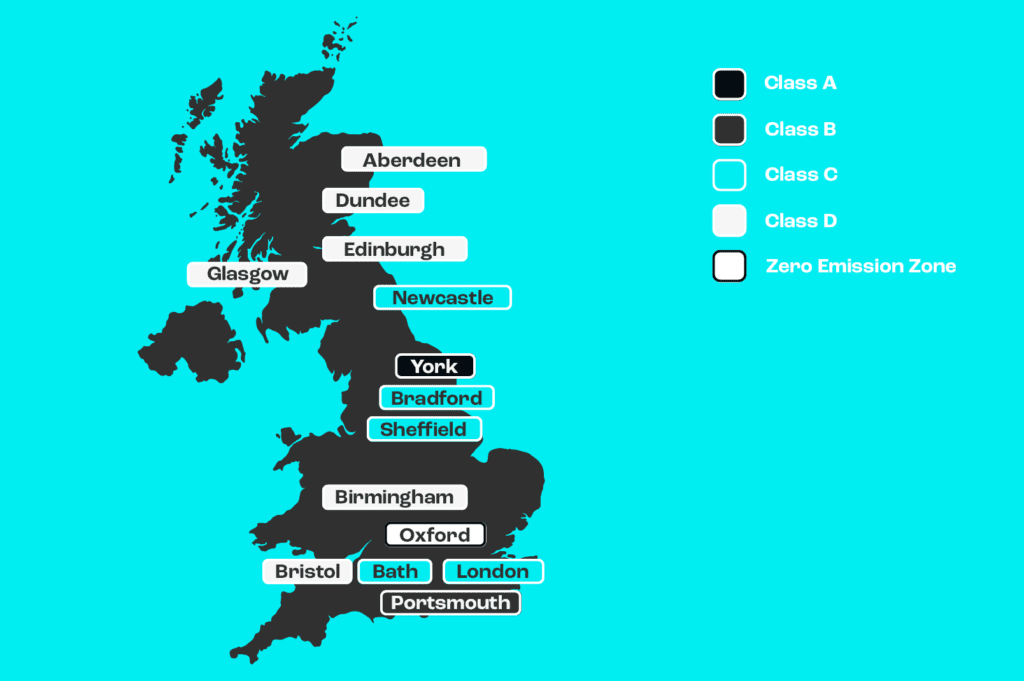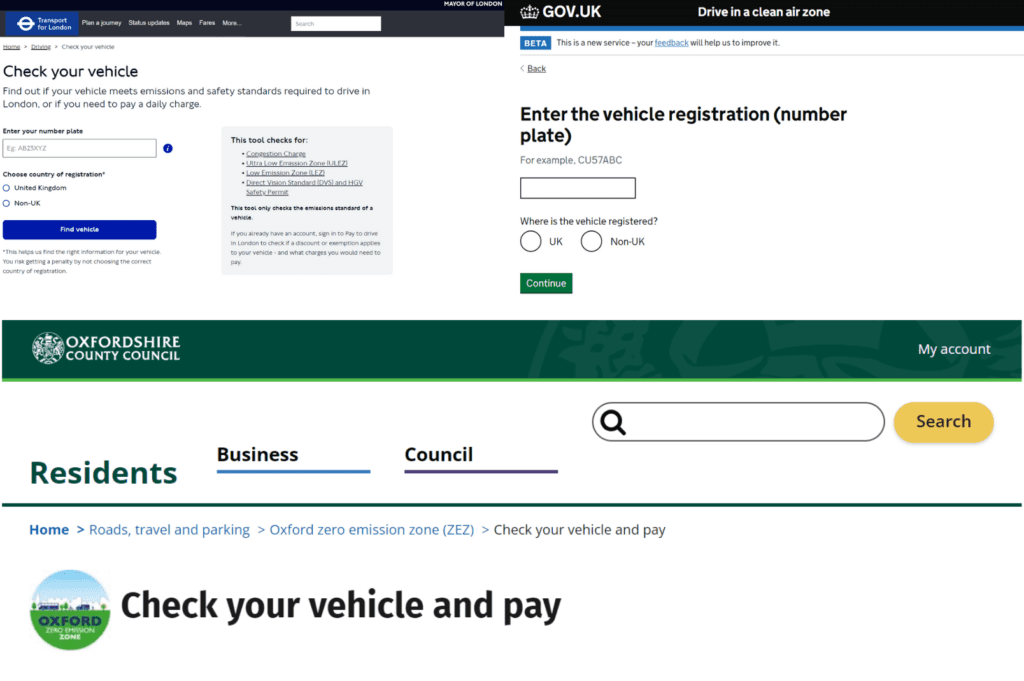Living in a busy city has a lot of plus points. Great transport links. Remarkable restaurants. Bustling nightlife. Better access to job opportunities.
But there are also downsides to city living, one of those being the quality of air.
It’s actually estimated that air pollution is the biggest environmental health threat in the UK, responsible for many premature deaths every year – mainly in urban areas.
That’s why the UK Government introduced the Clean Air Zone (CAZ) Framework, to help reduce the air pollution from vehicles in some of the UK’s busiest cities.
In this article, we’ll look at what Clean Air Zones are, why they were introduced, the different classes of CAZ, the cities that currently have a CAZ, and how you can check if your vehicle needs to pay a Clean Air Zone charge.
So, what is a Clean Air Zone, and why were they introduced?
Every vehicle that runs on petrol or diesel produces some polluting emissions that impact the environment and air quality.
One of the air pollutants produced by car exhausts is nitrogen dioxide, which can irritate airways and has been linked to respiratory issues.
In 2017, the UK Government implemented the Clean Air Zone Framework which included a long-term commitment to move towards zero-emission vehicles – which is one reason why the sale of all new diesel and petrol vehicles is set to end from 2030.
But that’s still a few years away.
So the framework also introduced a more immediate plan to reduce vehicle emissions in the cities most affected by vehicle air pollution, with the implementation of Clean Air Zones.
In simple terms, a Clean Air Zone puts restrictions or charges on certain types of high-polluting vehicles entering busy urban areas. CAZs were originally designed to only impact commercial vehicles like lorries, buses and taxis – but some cities have extended CAZ regulations to personal vehicles that emit certain levels of pollutants.
So if you’re driving an older petrol or diesel vehicle that falls below emissions standards and you drive into a Clean Air Zone, you might need to pay a charge. This is meant to encourage people to keep high emission vehicles out of busy city centres, helping to reduce pollution and improve air quality.
What are the different classes of Clean Air Zone?
To clear up any confusion – there is no difference in the emissions standards of each of the official Clean Air Zone. In relation to cars, the emissions standards set for all official CAZs is Euro 6 for diesel vehicles and Euro 4 for petrol vehicles.
The four classes of CAZ actually relate to the types of vehicle the zone affects.
Confused? Let us explain…
Class A Clean Air Zone
In a Class A CAZ, the only vehicles that are charged for falling below emissions standards are buses, coaches and taxis.
Class B Clean Air Zone
If you’re in a Class B CAZ, you can add another vehicle type to the list. Buses, coaches, taxis and HGVs are all targeted.
Class C Clean Air Zone
If you’re driving a bus, coach, taxi, HGV, van or minibus in a Class C CAZ – you’ll need to pay a charge if your vehicle falls below emissions standards.
Class D Clean Air Zone
This is the only class of CAZ that targets all vehicles, including privately owned cars. So if your car falls below emissions standards and you drive in a Class D zone, you’ll be liable to pay a charge.
Which cities currently have a Clean Air Zone?
At the minute, there are seven UK cities with active Clean Air Zones:
| Bath | Class C |
|---|---|
| Birmingham | Class D |
| Bradford | Class C |
| Bristol | Class D |
| Portsmouth | Class B |
| Sheffield | Class C |
| Tyneside | Class C |
Greater Manchester is currently considering implementing a Clean Air Zone, but the proposals are currently under review.
All straightforward so far, right?
It gets a little more complicated when you bring London and Oxford into the mix.
London has implemented its own scheme called the Ultra Low Emission Zone (ULEZ) which has similar criteria to a Class D CAZ. If vehicles don’t meet the ULEZ emissions standards, drivers are charged £12.50 per day to drive within the zone, which is being expanded to all London boroughs in August 2023.
Oxford has gone one step beyond the CAZ and ULEZ frameworks, and actually implemented a Zero Emission Zone (ZEZ) in the centre of the city, where only zero emission vehicles are permitted to travel without incurring a charge.
Are Clean Air Zones effective? Do they make a difference?
In a word – yes.
Since implementing the Ultra Low Emission Zone, London has seen a 46% reduction in nitrogen dioxide emissions in Central London, and a 21% reduction in Inner London.
Birmingham’s Clean Air Zone has resulted in a 13% reduction in nitrogen dioxide levels, with a significant reduction in the number of polluting vehicles entering the city centre.
And in the case of Oxford’s Zero Emission Zone, statistics show a 24% reduction in air pollution since 2019 levels.
So in terms of the Government’s plans for CAZ’s to help reduce air pollution in some of the UK’s busiest cities – the scheme is clearly working.
How can I check if my vehicle needs to pay a Clean Air Zone charge?
If you’re planning on driving through Oxford, London, Birmingham or Bristol in an older car, you might want to check if you need to pay a charge.
As a general rule, diesel cars that were first registered after September 2015 and petrol cars that were first registered after 2005 should meet emissions standards – but it’s easy to check by entering your registration number on the relevant website:
- Clean Air Zone
- Ultra Low Emission Zone (London)
- Zero Emission Zone (Oxford)
Looking to sell your car and upgrade to a more emission friendly vehicle?
If you have an older vehicle that doesn’t meet emissions standards and your travels regularly take you through a chargeable Clean Air Zone, the costs of charges can soon start mounting up.
You might possibly be thinking about selling your car and upgrading to a more emission friendly motor.
Flipit is a simple, hassle-free way to sell your car – and we buy any car, regardless of its age or condition.
We’re not like other car buying services. We promise you a fair price, and fully intend to stand by our initial valuation as long as all your information is accurate.
So if you’re sat there thinking “would someone buy my car?” – why not find out how much Flipit would offer you today?




